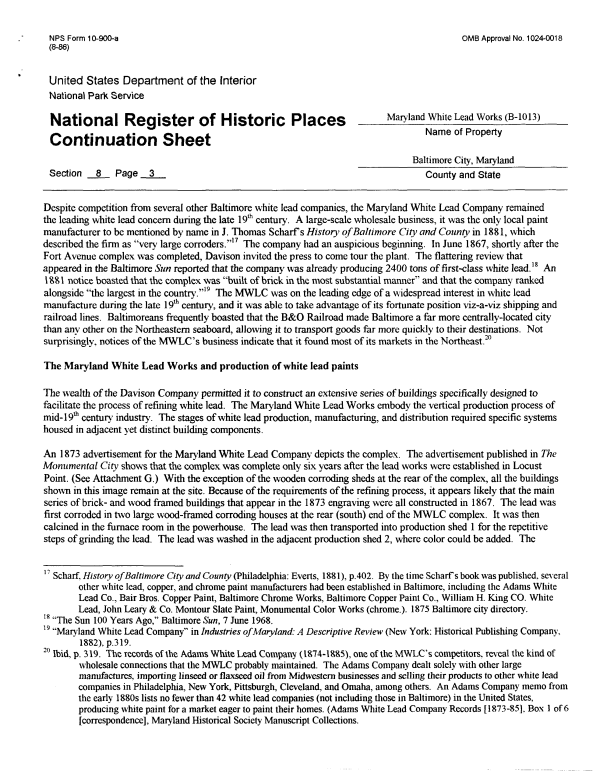 |
||||
|
DEPARTMENT OF HOUSING AND COMMUNITY DEVELOPMENT, MARYLAND HISTORICAL TRUST (Historic Sites Survey) var.d. MSA SE16-2 Image No: se16-2-0011 Enlarge and print image (96K) |
 |
||||
|
DEPARTMENT OF HOUSING AND COMMUNITY DEVELOPMENT, MARYLAND HISTORICAL TRUST (Historic Sites Survey) var.d. MSA SE16-2 Image No: se16-2-0011 Enlarge and print image (96K) |
| NPS Form 10-900-a OMB Approval No. 1024-0018 (8-86) United States Department of the Interior National Park Service National Register of Historic Places Ma^land WhiteLead Works(B-1013) ^N j. .. f+. . Name of Property Continuation Sheet Baltimore City, Maryland Section 8 Page 3 County and State Despite competition from several other Baltimore white lead companies, the Maryland White Lead Company remained the leading white lead concern during the late 19th century. A large-scale wholesale business, it was the only local paint manufacturer to be mentioned by name in J. Thomas Scharf s History of Baltimore City and County in 1881. which described the firm as "very large corroders."17 The company had an auspicious beginning. In June 1867, shortly after the Fort Avenue complex was completed, Davison invited the press to come tour the plant. The flattering review that appeared in the Baltimore Sun reported that the company was already producing 2400 tons of first-class white lead.18 An 1 $& 1 notice boasted that the complex was "built of brick in the most substantial manner" and that the company ranked alongside "the largest in the country7."19 The MWLC was on the leading edge of a widespread interest in white lead manufacture during the late 19th century, and it was able to take advantage of its fortunate position viz-a-viz shipping and railroad lines. Baltimoreans frequently boasted that the B&O Railroad made Baltimore a far more centrally-located city than any other on the Northeastern seaboard, allowing it to transport goods far more quickly to their destinations. Not surprisingly, notices of the MWLC's business indicate that it found most of its markets in the Northeast.20 The Maryland White Lead Works and production of white lead paints The wealth of the Davison Company permitted it to construct an extensive series of buildings specifically designed to facilitate the process of refining white lead. The Maryland White Lead Works embody the vertical production process of mid-19th century industry. The stages of white lead production, manufacturing, and distribution required specific systems housed in adjacent yet distinct building components. An 1873 advertisement for the Maryland White Lead Company depicts the complex. The advertisement published in The Monumental City shows that the complex was complete only six years after the lead works were established in Locust Point. (See Attachment G.) With the exception of the wooden corroding sheds at the rear of the complex, all the buildings shown in this image remain at the site. Because of the requirements of the refining process, it appears likely that the main series of brick- and wood framed buildings that appear in the 1873 engraving were all constructed in 1867. The lead was first corroded in two large wood-framed corroding houses at the rear (south) end of the MWLC complex. It was then calcined in the furnace room in the powerhouse. The lead was then transported into production shed 1 for the repetitive steps of grinding the lead. The lead was washed in the adjacent production shed 2, where color could be added. The 17 Scharf, History of Baltimore City and County (Philadelphia: Everts, 1881), p.402. By the time Scharf s book was published, several other white lead, copper, and chrome paint manufacturers had been established in Baltimore, including the Adams White Lead Co., Bair Bros. Copper Paint, Baltimore Chrome Works, Baltimore Copper Paint Co., William H. King CO. White Lead, John Leary & Co. Montour Slate Paint, Monumental Color Works (chrome.). 1875 Baltimore city directory. 18 "The Sun 100 Years Ago," Baltimore Sun, 1 June 1968. 19 "Maryland White Lead Company" in Industries of Maryland: A Descriptive Review (New York: Historical Publishing Company. 1882),p.319. 20 Md, p. 319. The records of the Adams White Lead Company (1874-1885), one of the MWLC's competitors, reveal the kind of wholesale connections that the MWLC probably maintained. The Adams Company dealt solely with other large manufactures, importing linseed or flaxseed oil from Midwestern businesses and selling their products to other white lead companies in Philadelphia, New York, Pittsburgh, Cleveland, and Omaha, among others. An Adams Company memo from the early 1880s lists no fewer than 42 white lead companies (not including those in Baltimore) in the United States, producing white paint for a market eager to paint their homes. (Adams White Lead Company Records [1873-85]. Box 1 of 6 [correspondence], Maryland Historical Society Manuscript Collections. |